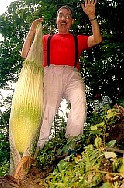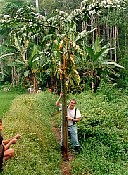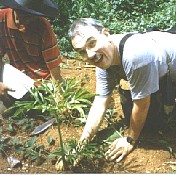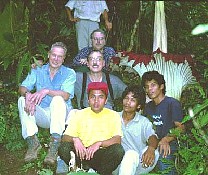|
|
This memorial is adapted from Aroideana, Volume 19, 1996. It is with a mixture of regret and satisfaction that the International Aroid Society dedicates Volume 19 of Aroideana, devoted to the genus Amorphophallus, to the memory of James R. Symon, MD. With the death of Dr. Symon on October 21, 1995, the Society lost an untiring champion of this genus and supporter of the Society. Although the man and his dedication will be sorely missed, this issue is a fitting tribute to his efforts. Jim came by his love of plants naturally and early in his life. His father, a trained botanist, took Jim at an early age to the Garfield Park Conservatory in Chicago, the city where Jim grew up. His mother and father both enjoyed growing their favorite plants, and among them was Amorphophallus konjac. Although Jim chose medicine as a career, plants were never far from his thoughts. He began his professional life as a practicing oncologist after graduating from the University of Illinois Medical School, and he began his serious interest in plants at the same time with an enthusiasm for the genus Iris. After several years he recertified in emergency medicine in order to have more free time in his work schedule for what had become his driving passion, the study of the genus Amorphophallus, particularly Amorphophallus titanum. Thus Jim began a quest that would animate the last few years of his life. His adventures began with a desire to see Amorphophallus titanum in situ. His interest quickly expanded to include all members of this genus, and he made numerous trips to Asia to study them, particularly to Thailand and to Indonesia. He eventually became so expert with the fieldwork in this region that he was asked in 1993 by Sir David Attenborough, who was filming "The Private Life of Plants", to organize his expedition to Sumatra. The result was that segment of this series that featured Amorphophallus titanum, and the gratitude of Attenborough, who acknowledged Jim in his companion book for his exceptional contribution to the project. My first meeting with Jim occurred at the airport in Singapore as we prepared to depart for Sumatra on the first of several field trips that we would take together. He arrived in a frenzy of energy, and the pace never slackened for the duration of the trip. To travel with him was to be infected with his enthusiasm for Amorphophallus and life in general, not to mention his sense of adventure. At one point we were even "detained" by the police as suspected thieves, having mistakenly loaded the bags of another traveler along with ours as we left our hotel. All of this just added to the excitement of the journey, as did floods, blocked highways, and the ever present mechanical mishaps. By the end of the trip we had succeeded in our mission one of Jim's years long dreams of rediscovering Amorphophallus hirsutus, one of the most elusive members of the genus in situ in Western Sumatra. As we traveled, Jim was hungry for any scrap of knowledge about these plants. He delighted in talking to the local people, finding out what the regional names for the species were and what they might use the plants for. At the same time he felt that it was his responsibility to impress upon them the unique nature of Amorphophallus and how they should value this very special botanical treasure that they possessed. When we next met it was to explore the jungles of Western Java to document the ecology of Amorphophallus decus-silvae, another giant of this genus. Even though Jim's health was failing significantly by this time, several months before his death, he let nothing compromise his dedication to the work that needed to be done. As he would often say during our times in the field, "What we do for phalloids!" Some of the tales of Jim's earlier adventures, when he began his fascination with Amorphophallus, are related in Volume 17 of Aroideana. Others will be remembered by his friends who had the good fortune to be entertained by his stories. Sadly, Jim died before he could finish his written narrative, just as he never had a chance to finish his investigations of Amorphophallus or to disseminate his knowledge about it. Hopefully this volume will serve to further the ends that he was so committed to until the last days of his life.
|



